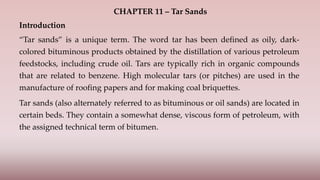Tar sands, also known as bituminous or oil sands, contain a dense and viscous form of petroleum called bitumen within certain sedimentary beds. The first commercial plant to extract oil from tar sands opened in 1978 in Alberta, Canada, producing one barrel of oil from two barrels of tar sand feedstock through a hot water separation process. Extraction of oil from tar sands poses potential environmental risks such as contaminating land, water, and air if not properly managed.













